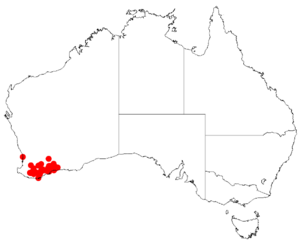Acacia laricina facts for kids
Quick facts for kids Acacia laricina |
|
|---|---|
| Scientific classification | |
| Genus: |
Acacia
|
| Species: |
laricina
|
 |
|
| Acacia laricina occurrence data from Australasian Virtual Herbarium | |
Acacia laricina is a type of shrub that belongs to the Acacia family, also known as Wattle. This plant is special because it grows only in the southwestern part of Australia.
What it Looks Like
This shrub usually grows to be about 0.25 to 0.5 metres (0.8 to 1.6 ft) tall, which is like half the height of a grown-up. It can grow in a dense, spreading, or dome-like shape. Its branches might have a fine, white powdery coating and can be a bit hairy at the ends.
Instead of regular leaves, Acacia laricina has what are called phyllodes. These are flattened leaf stems that look and act like leaves. The phyllodes are crowded together and seem to connect directly to the branches. They are mostly straight or slightly curved, about 15 to 50 mm (0.59 to 1.97 in) long and 0.7 to 1.7 mm (0.028 to 0.067 in) wide. They have five clear lines, or nerves, running along them.
From October to November, this plant produces cream-yellow flowers. These flowers grow in round clusters, with each cluster having 17 to 30 small flowers. After the flowers bloom, thin, reddish-brown seed pods form. These pods can be up to 4.5 cm (1.8 in) long and 2 to 4 mm (0.079 to 0.157 in) wide. They are curved and have rough lines on them. Inside the pods are shiny brown seeds, which are about 3.5 to 4 mm (0.14 to 0.16 in) long and have a small, cone-shaped tip called an aril.
Different Types
Scientists have found two main types, or varieties, of Acacia laricina:
- Acacia laricina var. crassifolia
- Acacia laricina var. laricina
Where it Grows
Acacia laricina is found in specific areas of Western Australia. These areas include parts of the southern Wheatbelt, Great Southern, and Goldfields-Esperance regions. It doesn't grow everywhere in these regions; its distribution is a bit spread out.
You can often find this shrub growing on flat lands, stony ridges, or on and around granite hills. It prefers loamy and gravelly soils, which are often found over a type of soil called laterite. Some of the places where it grows include areas around Nyabing in the northwest and Ravensthorpe in the southeast.

